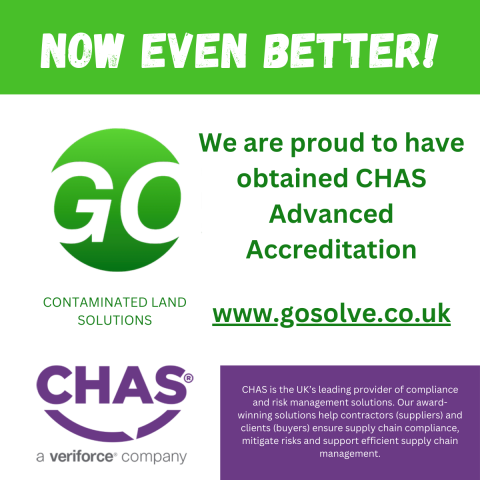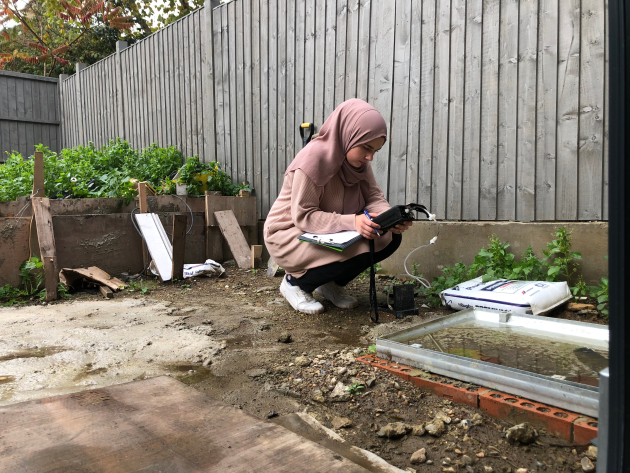CHAS Advanced Accreditation
GO Contaminated Land Solutions is pleased to announce that we have obtained CHAS Advanced Accreditation. CHAS is the Contractors Health and Safety Scheme. It is trusted as the leading provider of compliance and risk management solutions in the UK, setting benchmarks across a number of industries. These include construction, housing and development.
We are proud to be joining the CHAS database of contractors, reassuring prospective clients and collaborators of our compliance in areas such as Health & Safety, Environmental and Insurance, as well as regulations such as CDM 2015.
The official mark of compliance offered by the CHAS Advanced Accreditation allows us to pre qualify for projects, saving valuable time for companies who would like to work with us. The assessment of a contractor’s health and safety standards can be a lengthy process for a potential client; accreditation by CHAS makes this unnecessary!
More information can be found here : www.chas.co.uk

Is Brownfield First at Risk With Labour?
Some headlines might give that impression. What Sir Kier said is more nuanced. An article on the BBC news website provides more background:
"In an interview with BBC Breakfast, Sir Keir gave an example of homes being built on a playing field rather than a car park because the car park was technically within the green belt.
"We would make those tough choices and say to local areas, notwithstanding that it's greenbelt, if it's a car park or similar land which doesn't affect the beauty of our countryside… then we'll change the planning rules, we'll give you the powers to do that," he said."
The full article is here
Environmental Outcome Reports (EOR)
The government are currently running a consultation on a new scheme to replace Environmental Impact Assessment (EIA). They state:
"Part 6 of the Levelling Up and Regeneration Bill will secure powers to implement a new system of environmental assessment known as Environmental Outcomes Reports. This will allow the government to replace the EU-derived Strategic Environmental Assessment and Environmental Impact Assessment processes with a streamlined system that places greater focus on delivering our environmental ambitions.
The introduction of outcomes-based approach to the Environmental Outcomes Reports allows the government to reflect its environmental priorities directly into plan-making and decision-making process on the largest developments. The feedback from this consultation will help us establish our approach to developing these environmental outcomes across government."
The consultation advises that:
"Outcomes should:
- drive the achievement of statutory environmental targets and the Environment Improvement Plan
- be measurable using indicators at the correct scale ...
- be designed using the knowledge and experience of sector groups and environmental experts
- have an organisation responsible for monitoring overall progress of specific outcomes i.e., a responsible ‘owner’
- be reviewed on a regular basis to ensure they remain relevant
- not duplicate matters more effectively addressed through policy.
You can find out more and take part at DLHC.
SuDS, Adoption of Schedule 3 & Contaminated Land
It is thought likely that Schedule 3 will make SuDS mandatory and remove the automatic right to connection to the public sewer. It is anticipated that Schedule 3, will be implemented in England in 2024. There is an excellent article on this by Wavin.
If your site is contaminated, or potentially contaminated does that rule out the implementation of SuDS? No, there are still many ways in which SuDS can be successfully implemented but the ramifications of contaminated ground have to be taken into account. We can work with you to develop a SuDS scheme that works for your project, why not call me, Peter George, now to discuss your requirements (07765 232 995).
Introducing Environmental Consultant Azra - Our Newest Team Member
GO Contaminated Land Solutions proudly introduces Azra Koese, who has joined us as an Environmental Consultant.
Azra comes to us with impressive academic credentials, having gained both Bachelors's and Masters's Degrees in Ecology and Environmental Management in Agriculture, which she studied in her native Bosnia. This is her first job in her chosen profession.
Azra gained her role with us due to her success in our day-long interview process following a pre-interview assessment. This task involved completing unfinished environmental reports, which allowed us to evaluate her knowledge.
Azra was invited for a face-to-face interview and a practical assignment after passing this initial task. This involved being left on a development site to make initial environmental observations and assessments.

Needless to say, Azra passed with flying colors and is now a fully-fledged member of the team. She has also passed her 3-day First Aid at Work course, so she has another qualification.
Our photo shows Azra in action - monitoring ground gas in a borehole for a proposed basement.
Azra describes her position at GO Contaminated Land Solutions as the ideal first job, as she feels nurtured and can learn a lot from both Peter and Duncan's experience. She feels she can make progress within a supportive environment.
Welcome, Azra, and thank you for all your hard work so far!
Just Build Homes launches new portal
Just Build Homes say:
"Just Build Homes is a platform that connects supporters of housebuilding with the planning process to get more homes of all types built.
Over 5,000 people across the UK are now part of the Just Build Homes community. We have launched a new portal that enables anyone - a local resident, applicant or their agents - to add a scheme to build support. And what's more, it's free."

Spring Budget 2023
Landfill Tax Grant Scheme:
Background
On 21 July 2022 the government opened a “Call for Evidence on a Proposed Landfill Tax Grant Scheme for the Remediation of Contaminated Land”. This closed on 18 August 2022.
The Defra website states:
“The government is aware of instances in which the redevelopment, remediation, and / or protection of land affected by contamination or the consequences of previous development may be prevented by the cost of landfill, including the Landfill Tax. Landfill Tax has been highly effective since its implementation in diverting waste from landfill and underpinning the waste hierarchy by encouraging more sustainable waste management solutions. However, it is not intended that this tax should act in certain instances to prevent the redevelopment, remediation, or protection of land in the economic, environmental, and social interest of local communities.
This Call for Evidence seeks information on the prevalence of instances where Landfill Tax is considered an insurmountable barrier to the redevelopment of land affected by contamination or the consequences of previous development in England ...”
Budget Proposal
The government now proposes to develop a grant scheme to fund costs of Landfill Tax to public bodies in England, “where such costs are acting as a determinative barrier to the remediation and redevelopment of contaminated land”.
Landfill rates and tax review:
The government will uprate 2023-24 & 2024-25 Landfill Tax rates in line with the Retail Prices Index (RPI), from 1 April 2024. It was previously announced in the Autumn Budget 2021 that Landfill Tax rates from 1 April 2023 would be uprated in line with the RPI. From April 2023 the tax will rise by 3.5% from the current standard rate of £98.60 to £102.10. The lower rate, which generally applies to inactive or inert material, will rise by 10p from the current level of £3.15 to £3.25. Landfill Tax applies in England and Northern Ireland.
Warning to Landowners Who Allow Japanese Knotweed to Escape
Knotweed on local authority owned land had encroached onto a private property, the knotweed had subsequently been treated by the local authority. The home owner claimed damages.
On 3 February 2023 his Honour Judge Beard overturned a previous ruling, concluding that although the local authority had carried out reasonable and effective treatment to remove the Japanese Knotweed that the homeowner had suffered residual damage.
This judgment potentially opens the way for more claims against local councils which have allowed Japanese Knotweed to infest neighbouring property. Counsel for Mr Davies confirmed the importance of the Court of Appeal decision saying that “It confirms that a homeowner who suffers a loss in the value of their home from the stigma left from Japanese Knotweed even after it has been treated, can recover damages for that loss”. For more read the item by Jonathan Dinsdale of Blandy & Blandy
Buncefield - Historic Explosion - Current Toxic Legacy
The explosion and fire at the Buncefield oil depot in Hemel Hempstead occurred in 2005. This may seem a long time ago, however the foam used to fight this fire and many other sources have or a leaving a toxic legacy that does not break down once released into the environment.
These per- and polyfluoroalkyl substances (PFAS), used in a wide range of everyday items as well as firefighting foams and industrial processes can now be found in concerning concentrations in our soil and water.
There are two excellent articles in the Guardian on the scale of ‘forever chemical’ pollution and Buncefield: the PFAS legacy
Can the Nutrient Mitigation Scheme unlock developments
New housing developments, hotels and student accommodation, in the vicinity of vulnerable watercourses must demonstrate that they do not increase phosphate and nitrate levels beyond pre-consent levels.
The new ‘Nutrient Mitigation Scheme’ has been set up to enable developers to purchase government-backed credits, with the revenues raised invested in new and expanded wetlands and woodlands.
Two schemes have been announced, both within the Tees catchment. It will be interesting to see how effective these are both in terms of unlocking development and enhancing or at least protecting the environment.
An excellent article on Property Wire by Naomi Bull, associate, and Kate Radford, senior associate, at Eversheds Sutherland gives more detail.